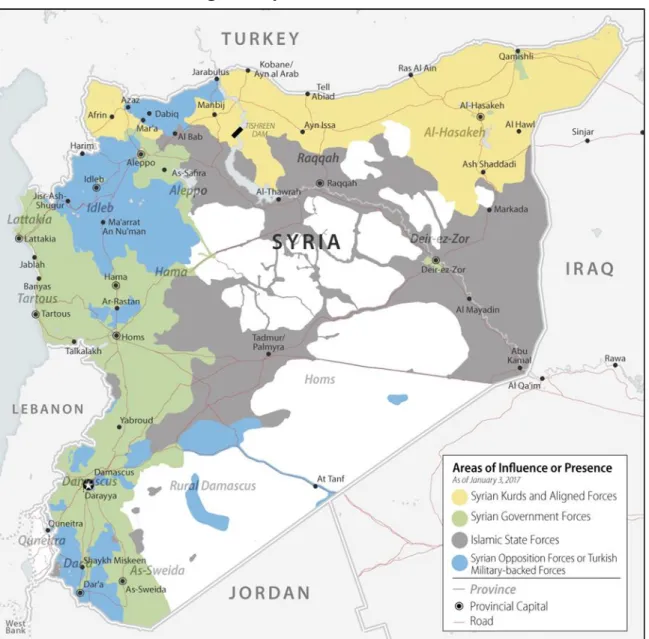The rise of the insurgent terrorist group known as the Islamic State (IS, also known as ISIL, ISIS or the Arabic acronym Da'esh) and Russia's military intervention on behalf of the Syrians. The United States remains the largest bilateral provider of such aid, with nearly US$6 billion in the United States. The United States has also committed more than $500 million to date to aid programs in Syria, including the provision of non-lethal equipment to selected opposition groups.
Syrian officials and their Russian and Iranian backers have stated their conditional willingness to serve as "counterterrorism" partners of the United States in Syria, provided the U.S. What is the United States' overall strategy toward the Syria conflict in general and toward the Islamic State in Syria and the Asad government in particular. The terms of the cessation of hostilities negotiated by the United States and Russia in 2016 called for an end to Syrian combat operations over opposition-held areas.
Widespread violations of the agreement by Syrian and Russian forces (and some violations by Syrian rebels) have renewed the debate over whether the United States should take unilateral military action to protect Syrian civilians. What responsibility does the United States have to protect US-backed forces that are under attack?
S. Policy and Assistance
In April, the United Kingdom and France reported to the United Nations that there was evidence that the Syrian government had used chemical weapons (CW) multiple times since December 2012.4 In August, the United States attributed a large-scale CW attack on . 5 White House, Government Assessment of the Use of Chemical Weapons by the Syrian Government August 21, 2013, August 30, 2013. With the outbreak of unrest in 2011, Russia provided sustained political, economic and military support to the Syrian government.
Permanent Representative to the United Nations Ambassador Samantha Power described the actions of the Syrian government and Russian forces in Aleppo as. Turkey views the YPG as the Syrian arm of the Kurdistan Workers Party (PKK), which both Turkey and the United States have designated a terrorist group. While the agreement resulted in a brief reduction in violence, the United Nations stated that the Syrian government had not allowed full humanitarian access.
On September 19, an aid convoy led by the Syrian Arab Red Crescent (SARC) was destroyed, apparently by airstrikes that the United States government attributed to Russian forces. Since 2012, the Syrian government and opposition have participated in negotiations mediated by the UN in the framework of the Geneva Communiqué. In the view of the Syrian government, a transitional government can be achieved simply by expanding the existing government to include members of the opposition.
39 Declaration on the Establishment of the Ceasefire Regime in the Syrian Arab Republic, contained in Annex I to the U.N.

S. Strategy and Policy
Changes in battlefield dynamics over time—particularly the rise and success of the Islamic State organization and other Salafist jihadist insurgent groups, the weakening of pro-Assad forces, and Russia's military intervention—have accompanied some shifts in the U.S. . In 2015, Secretary of Defense Carter described the "best-case" scenario for the Syrian people as one that would involve an agreed or managed removal of Asad and the merging of opposition forces with elements of the remaining Syrian state apparatus, as U.S. officials Obama administration and members of Congress expressed confidence. on the course of the campaign against the Islamic State, but debate continues over measures that could put greater economic or military pressure on the Asad government or more or different levels of support to various U.S.
Some analysts doubt that the Syrian government has the capacity to independently defend and administer the areas under its current control, much less restore its sovereign control and administrative authority over areas of the country that have slipped from it. Moreover, it is unclear whether the balance of power, in such a scenario, would rest with non-extremist opposition forces and the remnants of the Syrian state, even if somehow they were induced to work together. A more likely scenario than a formal partition of the country or reunification under moderate opposition forces may be one in which a de facto partition of Syria prevails and the United States, its partners, and its adversaries must manage negative consequences of an unclear, lasting conflict that is beyond their ability to resolve.
In congressional testimony in February 2016, Secretary of State John Kerry stated, “Our Pentagon estimates that to have a real safe zone in the north of the country you might need to have 15,000 to 30,000 troops. Some critics also argue that the image and influence of the United States has been weakened by its refusal to intervene to protect civilians or to respond forcefully to provocations from Asad or extremist forces. However, Congress has also failed to reach a consensus on whether or how a reduction in the involvement of the United States and its allies could better manage the negative impact of the ongoing conflict.
The FY2017 request for foreign assistance for Syria reflected the two main elements of the Obama administration's policy response: (1) humanitarian assistance to meet the needs of internally displaced Syrians and refugees in neighboring countries, and (2) continued political, economic and non-lethal military support for national and local opposition groups. The United States is also providing assistance to a range of anti-IS forces, including Kurdish and non-Kurdish members of the Syrian Democratic Forces (SDF) coalition and individuals from eastern Syria based near At-Tanf. Senior Obama administration officials have told Congress and the press that the administration is willing to provide military protection to U.S.-trained Syrian participants in the Train and Equip program in their engagements with Islamic State forces and if they are forces are attacked, including the Syrian government.60 In the case of.
However, the DOD-equipped forces have targeted the Islamic State and avoided involvement with the Syrian army. 60 Testimony of Secretary of State John Kerry, Secretary of Defense Ashton Carter and Chairman of the Joint Chiefs of Staff General Martin Dempsey before the Senate Foreign Relations Committee. Since the start of the Ministry of Defense-run Syria Train and Equip Program, there have been several reports of US-supplied weapons falling into the hands of the Nusra Front or the Islamic State.
S. Assistance to Syrians and the Syrian Opposition
Prior to the creation of the program and the expansion of the FY2016 foreign assistance authorities discussed above, congressional appropriators and authorizers did not provide the Administration. The establishment of the Syria Train and Equip Program by Congress in 2014 represents a further evolution of United States involvement in supporting Syrian opposition groups. 71 The program came under intense scrutiny in the wake of August and September 2015 reports that some of the small number of U.S.
National Security Council spokeswoman Bernadette Meehan said: “The United States is committed to strengthening the capabilities of the moderate opposition, including providing assistance to vetted members of the moderate armed opposition. A major political concern of the United States has been the use or loss of control of chemical weapons in Syria during the ongoing civil war. The Mission to Investigate Allegations of the Use of Chemical Weapons in the Syrian Arab Republic and the OPCW Fact-Finding Mission in Syria have investigated some of these allegations and found evidence that in some cases confirms and in others indicates that chemical weapons and/or toxic chemicals were used in attacks by the Syrian regime and the Islamic State.
Mission to Investigate Allegations of the Use of Chemical Weapons in the Syrian Arab Republic (UN Mission). The Security Council resolution further stipulated that Syria must abandon all its chemical weapons in accordance with the provisions of Chapter VII of the UN. The OPCW was unable to verify the completeness of the declaration, which is part of Syria's obligations under the CWC.
101 Government Assessment of the Syrian Government's Use of Chemical Weapons on August 21, 2013, White House Office of the Press Secretary, August 30, 2013. 102 Chapter VII of the UN Charter allows the use of punitive measures such as sanctions or military force. On August 22, 2016, the OPCW reported that 24 of its 27 declared chemical weapons production facilities (CWPFs) had been destroyed.
The Syrian Arab Republic emerged as an independent country during the Second World War after a period of French rule and nationalist unrest in the aftermath of the First World War. The Asad family are members of the minority Alawite sect (about 12% of the population), which has its roots in Shia Islam. The viciousness of the conflict and the devastation it has brought to large areas of the country have further shaped the opinions of members of Syria's diverse population.
Support for the Asad government by foreign Shia fighters has fueled some Sunnis' view of the regime as irredeemably sectarian. Other Christians have reportedly offered help to some elements of the armed opposition over time.
